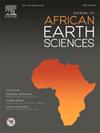Integrated sedimentological and petrophysical analyses for improved reservoir characterization in the sequence stratigraphy framework, Fahliyan Formation, southwest Iran
IF 2.2
4区 地球科学
Q2 GEOSCIENCES, MULTIDISCIPLINARY
引用次数: 0
Abstract
Fahliyan Formation is one of the important hydrocarbon reservoirs in south-western Iran. This study employs a comprehensive and integrated approach to reservoir characterization of this formation by combining petrographic, petrophysical, and sequence stratigraphic analyses. Various data types, including core descriptions, thin sections, well logs, and advanced clustering techniques, are utilized to enhance the accuracy of the analysis. By integrating these methodologies, this research provides a more detailed understanding of the reservoir properties, improving predictive capability for hydrocarbon exploration and development. For this purpose, petrographic and petrophysical data in two wells were used. Based on petrographic studies, six microfacies have been identified and grouped into three facies belts (lagoon, shoal and open marine). Fahliyan Formation has experienced various diagenetic processes including dissolution, cementation and dolomitization that have occurred in marine, meteoric and burial diagenetic environments. Four 3rd order sedimentary sequences have been identified (Sq- I is assigned to Manifa Member, Sq- II and III are associated with the Middle Yamama Member and Sq-IV corresponds to the Upper Yamama Member). Sequence boundaries determined through integrated prediction error filter analyses (INPEFA) and changes in microfacies. Reservoir zonation using the multi-resolution graph-based clustering method led to the identification of 6 electrofacies. In addition, based on K-means clustering by applying the Elbow method, three distinct hydraulic flow units (HFU) were determined. The comparison of results indicates that electrofacies 1 and 2, along with HFU 1, exhibit the lowest reservoir quality and are prevalent in the Upper Yamama Member. These electrofacies correspond to the sedimentary sub-environment of the lagoon and the mud-dominant microfacies. On the other hand, electrofacies 5 and 6 and HFU 2, 3 have the highest reservoir quality and are the most abundant in the Manifa and Middle Yamama members. These electrofacies and HFUs correspond to the sedimentary sub-environment of the shoal complex and the grain-dominant microfacies. In general, the regressive systems tracts have better reservoir quality than the transgressive systems tracts. This integrated analysis not only enhances the understanding of the Fahliyan Formation's reservoir characteristics but also serves as a valuable template for similar studies in other hydrocarbon reservoirs worldwide. The methodologies and findings presented here can be applied to improve reservoir characterization.
伊朗西南部Fahliyan组层序地层格架中改进储层表征的综合沉积学和岩石物理分析
法里扬组是伊朗西南部重要的油气储层之一。本研究通过结合岩石学、岩石物理和层序地层学分析,采用全面综合的方法对该地层进行储层表征。各种数据类型,包括岩心描述、薄片、测井和先进的聚类技术,都被用来提高分析的准确性。通过整合这些方法,本研究可以更详细地了解储层性质,提高油气勘探和开发的预测能力。为此,使用了两口井的岩石学和岩石物理数据。在岩石学研究的基础上,确定了6个微相,并将其划分为3个相带(泻湖、浅滩和开阔海)。法里岩组经历了海相、大气和埋藏成岩环境下的溶蚀、胶结和白云石化等多种成岩作用。确定了4个3级层序(Sq- 1属于曼尼伐段,Sq- 2和Sq- 3属于山山中段,Sq- 4属于山山上段)。通过综合预测误差滤波分析(INPEFA)和微相变化确定层序边界。利用基于多分辨率图的聚类方法进行储层划分,识别出6个电相。此外,基于K-means聚类,采用肘部法确定了三个不同的水力流量单元(HFU)。结果表明,1、2电相及1电相储层质量最低,主要分布在山山上段。这些电相对应于泻湖的沉积亚环境和泥质为主的微相。另一方面,5、6电相和HFU 2、3电相储层质量最高,在曼尼法和中山山段最富集。这些电相和高频相对应于浅滩杂岩的沉积亚环境和以颗粒为主的微相。总体而言,海退体系域的储层质量优于海侵体系域。这种综合分析不仅增强了对法里岩组储层特征的认识,而且为全球其他油气藏的类似研究提供了有价值的模板。本文提出的方法和发现可用于改进储层表征。
本文章由计算机程序翻译,如有差异,请以英文原文为准。
求助全文
约1分钟内获得全文
求助全文
来源期刊

Journal of African Earth Sciences
地学-地球科学综合
CiteScore
4.70
自引率
4.30%
发文量
240
审稿时长
12 months
期刊介绍:
The Journal of African Earth Sciences sees itself as the prime geological journal for all aspects of the Earth Sciences about the African plate. Papers dealing with peripheral areas are welcome if they demonstrate a tight link with Africa.
The Journal publishes high quality, peer-reviewed scientific papers. It is devoted primarily to research papers but short communications relating to new developments of broad interest, reviews and book reviews will also be considered. Papers must have international appeal and should present work of more regional than local significance and dealing with well identified and justified scientific questions. Specialised technical papers, analytical or exploration reports must be avoided. Papers on applied geology should preferably be linked to such core disciplines and must be addressed to a more general geoscientific audience.
 求助内容:
求助内容: 应助结果提醒方式:
应助结果提醒方式:


